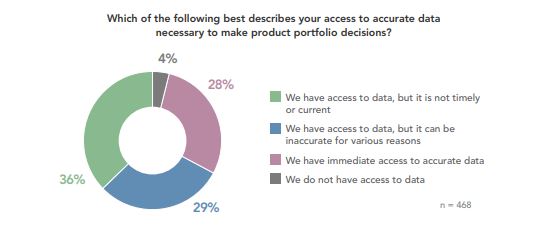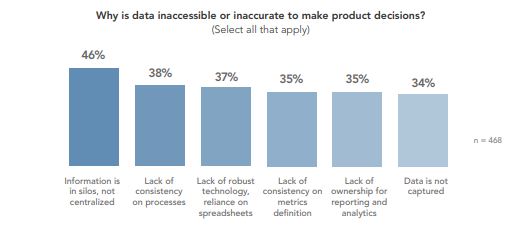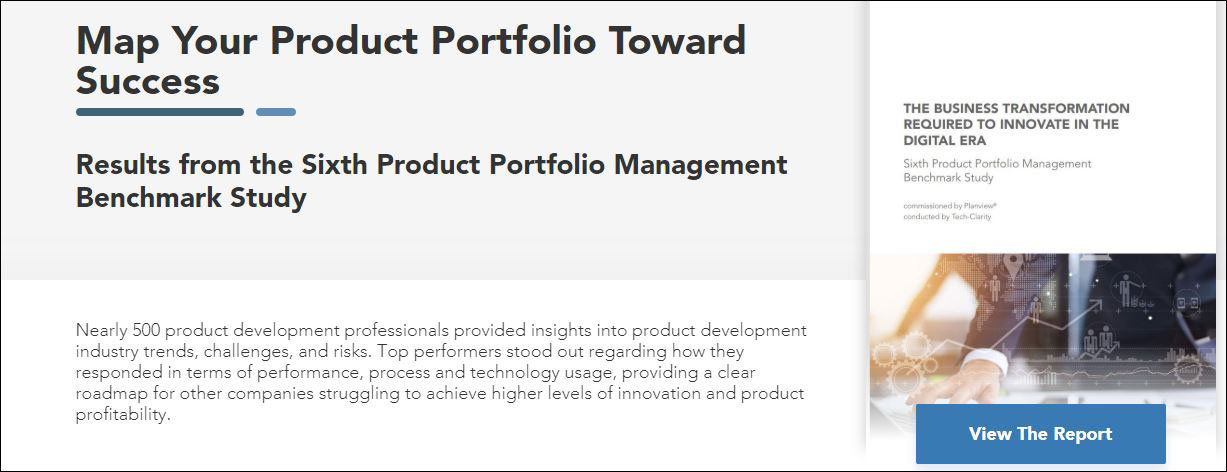
In the first three parts of this series, we covered the importance of addressing the challenges of modern portfolio management. Increasing complexity, addressing it through innovation investment and strategy alignment, and best practices for execution are critical—and data visibility is key. Catch up on anything you may have missed by reading through the first three parts below:
- Part 1: The Complexity of Managing Smarter, More Connected Products
- Part 2: Connecting Innovation Investments with Delivery
- Part 3: Managing Product Portfolio Challenges in the Digital Age
Part 4: Optimize Data Visibility. Mitigate Data Scarcity.
Every year or so, Planview commissions a study to report on industry progress in the arena of portfolio management, the top performers, and their approach to achieving that top-tier success. This year, we commissioned the Sixth Product Portfolio Management Benchmark Study (conducted by Tech-Clarity). One of the many things we learned is that data driven decisions played a critical role in meeting launch dates and revenue targets.
As we covered in earlier pieces, the rate of technology evolution is accelerating, and that, in turn, is driving a business need for innovation. But how and what to innovate is dependent on current and reliable data.
With that in mind, it’s easy to understand what the study indicated: companies don’t have current, reliable data or that it takes too long to gather and manually massage product portfolio information.
Access to Data Is Key
Data is, or should be, the foundation for decision making for every organization. Yet nearly one-third of the product professionals surveyed said their data is inaccurate, and 36 percent said their data is not timely or current. Companies, however, are learning and acting.
According to the 2018 study, only 4% of study participants had no access to data, compared to 28% that reported they had immediate access to accurate data, which nearly doubled from 2013.
The Perils of Data Scarcity
Aggregating the statistics of those who reported accessible data as inaccurate or untimely remains a staggering 2/3, which is stifling strategically planned innovation. But given the critical nature of that data, the study delved into the question of “Why?” Respondents pointed to the following reasons:
- Information is in silos, rather than centralized – 46%
- Lack of consistency on processes – 38%
- Lack of robust technology and a reliance on spreadsheets – 37%
- Lack of consistency on metrics definition – 35%
- Lack of ownership for reporting and analytics – 35%
- Data is not captured – 34%
The key to unlocking product innovation is removing these obstacles, enabling product leaders to dynamically adapt to changing market conditions, understand current project status, and reduce risk.
Start off Slowly If You Have to, but Start
Another thing we found is that many companies are operating blind, neglecting to address the issue of data scarcity. As stated earlier, 65% of product leaders are making decisions that are misguided by either inaccurate or untimely data. The result is less than stellar performance in hitting launch and revenue targets.
In fact, the study demonstrated that companies are much better at meeting engineering targets—getting their products to meet scope and quality goals—than achieving their revenue and launch targets. A good place to start in resetting these priorities is in-line extensions and small product modifications.
Beginning in these relatively simple areas, you can begin to move your organization forward and, from there, you can scale up your efforts by adopting tools and processes enterprise-wide.
Top Performers Are Blazing the Trail
Top performers are exploiting the discipline of timely and accurate data access. In fact, their performance is directly tied to harnessing data across the organization and using it to drive strategic innovation decisions.
They also all have something in common that under-performers are lacking: a single source of truth for decision making. As a result, they are almost 60% more likely to have immediate access to accurate data. In that vein, they offered several concerns that organizations would do well to consider as they strive to successfully meet revenue and launch expectations:
- Do we have access to accurate data and decision tools?
- How can we attain instant access to data for forecasting?
- Is data being held by other organizations or is it otherwise difficult to access?
- Has management been unwilling to spend to get more accurate and reliable data?
- Do team members rely too much on email, voice mail, memory, or gut rather than relying on a centralized system?
Follow along with this eight-part series regarding the discipline and importance of PPM to transform your organization into one of the top performers we’ve described, listed below:
- Part 5: Product Development Processes: Changing the Game
- Part 6: Technology: The Key to Resolving Product Portfolio Challenges
- Part 7: A Product Development Process for Successful Strategic Outcomes
- Part 8: 6 Product Portfolio Management Best Practices
Check out the results and “Map Your Product Portfolio Toward Success.” Also, don’t forget to read the full benchmark report “The Business Transformation Required to Innovate in the Digital Era” and to register for the webinar, “The Surprising Secrets to Delivering Smarter, More Connected Products,” to learn more.





![Product Portfolio Management in the Digital Era [Webinar]](https://blog.planview.com/wp-content/uploads/2017/09/Product-Portfolio-Management-in-the-Digital-Era-750x400.jpg)

